Growing up in Scotland: overweight obesity and activity
Report describing the influences of parental factors and family and neighbourhood factors on childrens's weight and sedentary behayiour.
CHAPTER 5 MOTHERS' AWARENESS AND CONCERN FOR CHILDREN'S OVERWEIGHT
5.1 Key findings
- Few mothers recognised overweight or obesity, or expressed concern about an overweight child's weight. However, concern for the child's weight was markedly higher with correct identification of the child's overweight.
- Mothers were more likely to identify their child as overweight if the child was obese, rather than overweight. A mother was also more likely to identify a weight problem in a daughter, or if she was overweight herself.
- Correct identification of overweight at age 4 was not associated with the child losing weight by age 6, suggesting that helping mothers recognise overweight in children is not likely to be a sufficient solution to weight management.
5.2 What proportion of mothers recognised their child's overweight or obesity?
Mothers were asked to classify their child's weight using one of four options: underweight, normal weight, somewhat overweight or very overweight. 18
Most mothers of children classified as overweight or obese at age 6 described their child as being of "normal" weight, with only 14% describing them as overweight (see Figure 5.1). Recognition of overweight was greater among mothers of obese children, but even among this group, around two-thirds described their child as being of normal weight.
Figure 5.1 Mother's description of their child's weight, according to the child's BMI classification at age 6
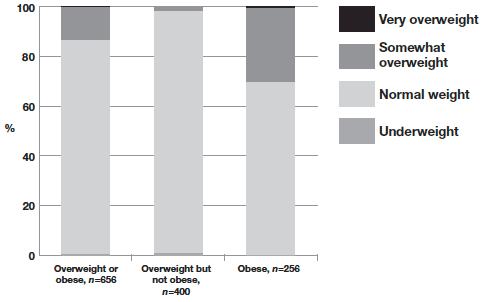
5.3 What proportion of mothers recognised their own overweight?
Mothers appeared more able to recognise overweight in themselves than in their child. Most mothers who were classified as obese or overweight on the basis of their BMI at age 6 identified themselves as either "somewhat" or "very" overweight. This included 70% of mothers who were overweight but not obese, and 97% of obese mothers. Less than 2% of mothers who were overweight but not obese described themselves as "very" overweight, compared to 30% of obese mothers reporting they were "very" overweight.
5.4 Factors associated with mothers' failure to recognise children's overweight or obesity at age 6
We explored whether maternal overweight or obesity, and various socio-demographic characteristics, were associated with a failure to recognise children's overweight or obesity 19 . Maternal and family characteristics related to social deprivation were not clearly associated with non-recognition of overweight in children. However, mother's BMI, child gender and height all appeared to be associated with recognition of overweight.
5.4.1 Mother's BMI classification and recognition of child's overweight
Mothers who were themselves overweight or obese at age 6 were more likely to recognise overweight or obesity in their children than mothers who were a healthy weight (Figure 5.2). Even so, two-thirds of overweight or obese mothers described their obese children as of normal weight (Figure 5.2 part B).
Figure 5.2 Mother's description of overweight or obese children at age 6 according to mother's BMI classification
A) Mothers with an overweight or obese child
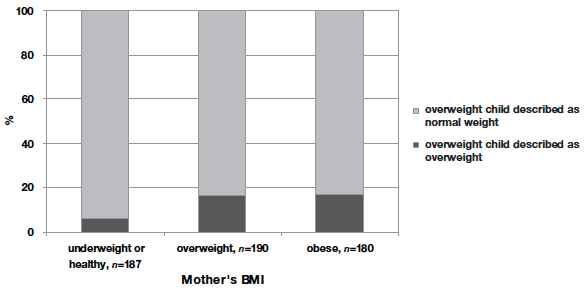
B) Mothers with an obese child
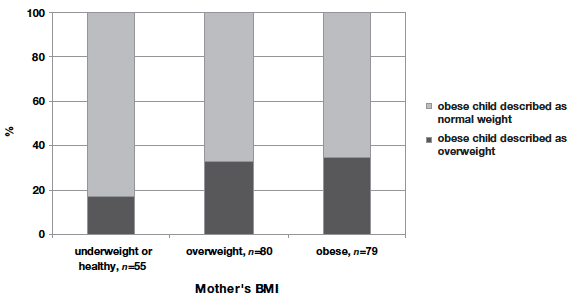
5.4.2 Child characteristics associated with non-recognition of children's overweight or obesity: gender
Mothers were less likely to recognise weight problems in boys compared to girls (Figure 5.3).
Figure 5.3 Mother's description of overweight or obese children at age 6 according to child's gender, n=256
A) Child BMI classified as overweight or obese
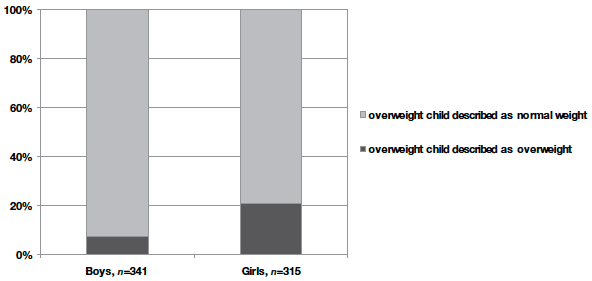
B) Child BMI classified as obese
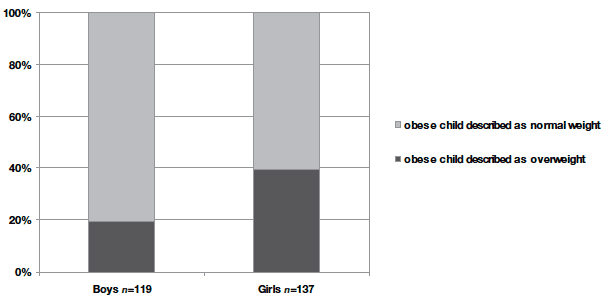
5.4.3 Multivariate model of factors associated with mothers' recognition of overweight in their child
In sections 5.4.1 and 5.4.2, associations between various factors and mother's recognition of child overweight were examined individually. A multivariate model of mother's recognition allowed various influences to be examined simultaneously: these were the effect of child's BMI classification (overweight, obese or morbidly obese), gender and height, together with the mother's BMI classification as healthy weight, overweight or obese.
This model showed that amongst the subsample containing overweight or obese children, mothers were more likely to describe an overweight child as overweight if the child was obese or morbidly obese, if the child was a girl and if the mother was herself overweight 20 . The difference in description according to the child's gender has been found elsewhere (Vanhala et al. 2011).
We also examined factors associated with the mother's description of their child as overweight in the whole GUS sample - not just those cases where the child was overweight or obese - as other research has suggested that overweight mothers are less likely to describe a child as overweight (Layte and McCrory 2011; Parkinson et al. 2011). In the GUS data there was no evidence for a similar effect. Across the whole sample, mothers were more likely to describe a child as overweight if they were a girl, or if the child was classified as overweight or obese on the basis of BMI. Amongst mothers of all children, there was no significant effect of the mother's own BMI on a mother's description of a child as overweight.
5.5 Mothers' concerns about weight
5.5.1 Mothers' concerns about their child's weight
Across the whole GUS sample, mothers were more likely to express concern about their child's weight at age 6 if their child was underweight or obese (Figure 5.4). As with recognition of the child's weight, levels of concern were generally low. Only 5% of mothers of overweight children and 18% of mothers of obese children expressed concern, although 44% of mothers of morbidly obese children were concerned.
Figure 5.4 Mothers expressing concern about child's weight, according to child's BMI classification at age 6
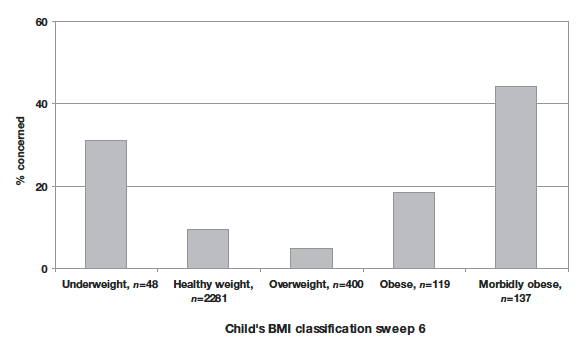
5.5.2 Association between mothers' recognition of child's overweight and concern
Although mothers were asked about any concerns regarding the child's weight before they were asked to describe whether the child was overweight, mother's recognition of overweight was strongly associated with concern.
Only 6% of mothers who did not recognise that their child was overweight expressed concern about the child's weight. In contrast, among mothers correctly identifying a child as overweight, the vast majority (81%) expressed concern about the child's weight.
5.5.3 Mothers' concerns about their own weight
Mothers' levels of concern about their own overweight were much higher than for their child's overweight. 70% of mothers who were overweight but not obese expressed some concern, although less than 2% were "very concerned" about their own weight. Among mothers who were obese, 88% were concerned, including 18% who were "very" concerned.
5.5.4 Factors associated with greater mothers' concern for overweight children
Given that mothers who were overweight or obese themselves were more likely to recognise a child's overweight, and that higher recognition was apparently linked to greater concern, we might expect that overweight or obese mothers would be more concerned about their child's weight.
In fact, levels of concern among mothers did not differ clearly according to whether a mother herself was overweight or not. Recognition levels were very low generally, and the effect of higher recognition on overweight mothers' concern was negligible. Mothers' concerns were also not clearly associated with factors linked to social deprivation.
Mothers of overweight children were more likely to worry about a girl's weight (24% were concerned) than a boy's weight (only 10% were concerned, gender difference statistically significant p<0.001).
5.6 Did mother's awareness of, and concern for, overweight at age 4 help their child to lose weight?
A mother's recognition of her child's overweight and concerns in relation to this overweight may enable her to manage the child's diet and activity. We looked at whether identification of a child's overweight and mother's concern at age 4 was associated with weight loss by age 6.
Four in ten of children who were classified as overweight at age 4 were no longer overweight at age 6. However, this improvement in weight status was not associated clearly with a mother's recognition of child overweight at age 4, or with her concerns about the child's weight at this time.
A third (34%) of children whose mothers were concerned were no longer overweight by age 6, compared with 40% of those whose mothers did not appear concerned (difference not statistically significant). Moreover, 40% of mothers who incorrectly saw their child's overweight as "normal" at age 4 were no longer overweight by age 6, compared to 22% of mothers who correctly identified their child as overweight at age 4 ( p<0.05).
The association between recognition and weight change appeared to be in the opposite direction to what might be expected from the predicted relationship between mother's recognition/concern and better weight management. It may be that mothers found it less easy to identify overweight in children who were borderline overweight at age 4, and that it was these children who were reclassified at age 6 as of healthy weight. Work elsewhere (Jones et al. 2011a) supports the idea that parents tend to use extreme models of overweight as a reference point.
Contact
There is a problem
Thanks for your feedback